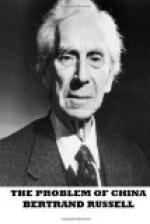There are certain broad features of the traditional Chinese civilization which give it its distinctive character. I should be inclined to select as the most important: (1) The use of ideograms instead of an alphabet in writing; (2) The substitution of the Confucian ethic for religion among the educated classes; (3) government by literati chosen by examination instead of by a hereditary aristocracy. The family system distinguishes traditional China from modern Europe, but represents a stage which most other civilizations have passed through, and which is therefore not distinctively Chinese; the three characteristics which I have enumerated, on the other hand, distinguish China from all other countries of past times. Something must be said at this stage about each of the three.
1. As everyone knows, the Chinese do not have letters, as we do, but symbols for whole words. This has, of course, many inconveniences: it means that, in learning to write, there are an immense number of different signs to be learnt, not only 26 as with us; that there is no such thing as alphabetical order, so that dictionaries, files, catalogues, etc., are difficult to arrange and linotype is impossible; that foreign words, such as proper names and scientific terms, cannot be written down by sound, as in European languages, but have to be represented by some elaborate device.[15] For these reasons, there is a movement for phonetic writing among the more advanced Chinese reformers; and I think the success of this movement is essential if China is to take her place among the bustling hustling nations which consider that they have a monopoly of all excellence. Even if there were no other argument for the change, the difficulty of elementary education, where reading and writing take so long to learn, would be alone sufficient to decide any believer in democracy. For practical purposes, therefore, the movement for phonetic writing deserves support.




